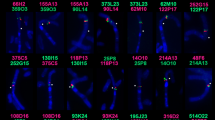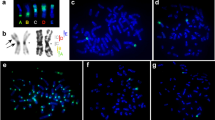Summary
From the 15 diverse species of placental mammals investigated cytologically in this laboratory, seven species and one interspecific hybrid were selected for the present study : man (Homo sapiens, 2n=46), cattle (Bos taurus, 2n=60), the cat (Felis domestica, 2n=38), the dog (Canis familiaris, 2n=78), the mouse (Mus musculus, 2n=40), the golden hamster (Mesocricetus auratus, 2n=44), the creeping vole (Microtus oregoni, 2n=17/18), and the mule (2n=63).
We devised a method for making two-dimensional measurements of chromosomes which produced the following results:
-
1.
Despite the wide variation in chromosome number, the eight species had diploid chromosome complements which appeared to contain about the same amount of genetic material, varying from 145.14 μ2 in the mouse to 165.73 μ2 in cattle.
-
2.
The X-chromosome of the dog, the donkey, and cattle appeared to be almost identical in absolute size, ranging from 4.11 to 4.65 μ2. Although only presumptive identification of the X is possible in the cat, the mouse, man, and the horse, they too seemed to fall within the same size range (3.75–5.07 μ2).
Phylogenic studies of vertebrate sex chromosomes suggest that the X in the great majority of placental mammals retains the original size and genetic constitution of a common ancestor. In the golden hamster, the X is twice this size (8.33 μ2) and is regarded as a duplicate; in the creeping vole, three times (12.70 μ2), a triplicate. In the latter species, the sex chromosome constitution of somatic cells in the normal female is XO.
-
3.
Each of the three X-chromosome types demonstrated a distinctive behavior pattern in somatic cells. If positive heteropycnosis can be equated with genetic inertness, then all the species in this study appeared to have about the same amount of functioning X-chromosome material in diploid nuclei of both sexes. The ambivalent nature of the mammalian X apparently provides the mechanism which maintains the constant optimal ratio between the functional X and the autosomes in somatic cells.
Similar content being viewed by others
References
Allfrey, V. G., A. E. Mirsky, and H. Stern: The chemistry of the cell nucleus. Advanc. Enzymol. 16, 411–500 (1955).
Awa, A., M. Sasaki, and S. Takayama: An in vitro study of the somatic chromosomes in several mammals. Jap. J. Zool. 12, 257–265 (1959).
Barr, M. L.: Das Geschlechtschromatin (The sex chromatin), in Die Intersexualität, ed. by Claus Overzier. Stuttgart: Georg Thieme 1961.
—, and L. F. Bertram: A morphological distinction between neurones of the male and female and the behavior of the nucleolar satellite during accelerated nucleoprotein synthesis. Nature (Lond.) 163, 676–677 (1949).
Beçak, W., M. L. Beçak, and H. R. S. Nazareth: Karyotypic studies of two species of South American snakes (Boa constrictor amarali and Bothrops jararaca). Cytogenetics 1, 305–313 (1962).- Karyotypic studies of South American snakes. Presented before the XI Internat. Congr. of Genetics, The Hague, 1963.
Benirschke, K., L. E. Brownhill, and M. M. Beath: Somatic chromosomes of the horse, the donkey and their hybrids, the mule and the hinny. J. Reprod. Fertil. 4, 319–326 (1962).
Beutler, E., Mary Yeh and V. F. Fairbanks: The normal human female as a mosaic of X-chromosome activity: studies using the gene for G-6-PD-deficiency as a marker. Proc. nat. Acad. Sci. (Wash.) 48, 9–16 (1962).
Clausen, J. J., and J. T. Syverton: Comparative chromosomal study of 31 cultured mammalian cell lines. J. nat. Cancer Inst. 28, 117–145 (1962).
Cox, E. K.: The chromosomes of the house mouse. J. of Morph. Physiol. 43, 45–53 (1926).
Field, R. A., and C. G. Rickard: Hemophilia in a family of dogs. Cornell Vet. 36, 285–300 (1946).
Hsu, T. C., H. H. Rearden, and G. F. Luquette: Karyological studies of nine species of Felidae. Amer. Naturalist 97, 225–234 (1963).
Humphrey, R. R.: Reversal of sex in females of genotype WW in the axolotl (Siredon or Ambystoma mexicanum) and its bearing upon role of the Z-chromosomes in the development of the testis. J. exp. Zool. 107, 171–186 (1948).
Kleinfeld, R., and E. H. Y. Chu: DNA determinations of kidney cell cultures of three species of monkeys. Cytologia (Tokyo) 23, 452–459 (1958).
Leuchtenberger, C., R. Vendrely, and C. Vendrely: A comparison of the content of desoxyribose nucleic acid (DNA) in isolated animal nuclei by cytochemical and chemical methods. Proc. nat. Acad. Sci. (Wash.) 37, 33–38 (1951).
Levan, A., T. C. Hsu, and H. F. Stich: The idiogram of the mouse. Hereditas (Lund) 48, 676–687 (1962).
Lyon, M. F.: Gene action in the X-chromosome of the mouse (Mus musculus L.) Nature (Lond.) 190, 372–373 (1961).
Makino, S., and T. C. Hsu: Mammalian chromosomes in vitro. V. The somatic complement of the Norway rat, Rattus norvegicus. Cytologia (Tokyo) 19, 23–28 (1954).
Matthey, R.: Les chromosomes sexuels géants de Microtus agrestis L. La Cellule 53, 163–184 (1950);- Un nouveau type de détermination chromosomique du sexe chez les mammifères Ellobius lutescens Th. et Microtus (Chilotus) oregoni Bach. (Muridés-Microtinés.) Experientia (Basel) 14, 240 (1958);-Matthey, R. Chromosomes, héterochromosomes et cytologie comparée des cricetinae paléarctiques (Rodentia). Caryologia (Firenze) 13, 199–223 (1960).
Mirsky, A. E., and H. Ris: Variable and constant components of chromosomes. Nature (Lond.) 163, 666–667 (1949).
Moore, K. L., and M. L. Barr: Nuclear morphology, according to sex, in human tissues. Acta anat. (Basel) 21, 197–208 (1954).
—, M. A. Graham and M. L. Barr: The sex chromatin in the bovine freemartin. J. exp. Zool. 135, 101–125 (1957).
Mustard, J. F., H. C. Roswell, G. A. Robinson, T. D. Hoeksema and H. G. Downie: Canine hemophilia B (Christmas disease). Brit. J. Haemat. 6, 259–266 (1960).
Ohno, S., and T. S. Hauschka: Allocycly of the X-chromosome in tumors and normal tissues. Cancer Res. 20, 541–545 (1960).
—, J. Jainchill, and C. Stenius: The creeping vole (Microtus oregoni) as a gonosomic mosaic. I. The OY/XY constitution of the male. Cytogenetics 2, 222–239 (1963).
—, W. D. Kaplan, and R. Kinosita: Heterochromatic regions and nucleolus organizers in chromosomes of the mouse, Mus musculus. Exp. Cell Res. 13, 358–364 (1957); Formation of the sex chromatin by a single X-chromosome in liver cells of Rattus norvegicus. Exp. Cell Res. 18, 415–418 (1959).
-, and S. Makino: The single X nature of the sex chromatin in man. Lancet 1961 I, 78–79.
—, C. Stenius, C. Weiler, J. Trujillo, W. D. Kaplan, and R. Kinosita: Early meiosis of male germ cells in fetal testis of Felis domestica. Exp. Cell Res. 27, 401–404 (1962).
—, J. Trujillo, C. Stenius, L. C. Christian, and R. Teplitz: Possible germ cell chimeras among newborn dizygotic twin calves (Bos taurus). Cytogenetics 1, 258–265 (1962).
—, and C. Weiler: Sex chromosome behavior pattern in germ and somatic cells of Mesocricetus auratus. Chromosoma (Berl.) 12, 362–373 (1961).
Robinson, A., Ed.: A proposed standard system of nomenclature of human mitotic chromosomes. J. Amer. med. Ass. 174, 159–162 (1960).
Rothfels, K. H., A. A. Axelrad, L. Siminovitch, E. A. McCulloch, and R. C. Parker: The origin of altered cell lines from mouse, monkey, and man as indicated by chromosome and transplantation studies. Canad. Cancer Conf. 3, 189–214 (1959).
Sachs, L., and M. Danon: Diagnosis of the sex chromosomes in human tissues. Genetica (s'Gravenhage) 28, 201–216 (1956).
Saksela, E., and P. S. Moorhead: Enhancement of secondary constrictions and the heterochromatic X in human cells. Cytogenetics 1, 225–244 (1962).
Sasaki, M. S., and S. Makino: Revised study of the chromosomes of domestic cattle and the horse. J. Hered. 53, 157–162 (1962).
Schmid, W.: Personal communication 1963.
Schneider, S. Personal communication 1963.
Takahashi, M.: Sex difference found in nucleomorphology of nerve cells of some mammals. Zool. Mag. 61, 26 (1952).
Taylor, J. H.: Duplication of chromosomes and related events in the cell cycle. In: Cell physiology of neoplasia. Austin: Univ. of Texas Press 1960.
Tjio, J. H., and A. Levan: The chromosome number of man. Hereditas (Lund) 42, 1–6 (1956).
Trujillo, J. M., C. Stenius, L. C. Christian, and S. Ohno: Chromosomes of the horse, the donkey, and the mule. Chromosoma (Berl.) 13, 243–248 (1962).
Wahrman, J., and A. Zahavi: Cytological contributions to the phylogeny and classification of the rodent genus Gerbillus. Nature (Lond.) 175, 600–602 (1955).
Weiler, C., and S. Ohno: Emergence of the heteromorphic sex pair in North American Ranidae. (In preparation.)
Yamamoto, T.: Progeny of artifically induced sex-reversals of male genotype (XY) in the medaka, Oryzias latipes, with special reference to the YY-male. Genetics 40, 406–419 (1955).
Yerganian, G.: Chromosomes of the Chinese hamster, Cricetulus griseus. I. The normal complement and identification of sex chromosomes. Cytologia (Tokyo) 24, 66–75 (1959).
Author information
Authors and Affiliations
Additional information
Contribution No. 22-63, Department of Biology, City of Hope Medical Center. This work was supported in part by grant CA-05138-04, National Cancer Institute, U. S. Public Health Service. In order to spend three months in this laboratory, W. Beçak and M. L. Beçak of the Secção de Genética, Instituto Butantan, São Paulo, Brasil, received travel grants respectively from the Institute for Advanced Learning in the Medical Sciences, City of Hope Medical Center, and from the Campanha Nacional de Aperfeiçoamento de Pessoal de Nivel Superior, Republic of Brasil.
The authors acknowledge with gratitude the editorial assistance of Patricia A. Ray.
Rights and permissions
About this article
Cite this article
Ohno, S., Beçak, W. & Beçak, M.L. X-autosome ratio and the behavior pattern of individual X-chromosomes in placental mammals. Chromosoma 15, 14–30 (1964). https://doi.org/10.1007/BF00326912
Received:
Issue Date:
DOI: https://doi.org/10.1007/BF00326912




